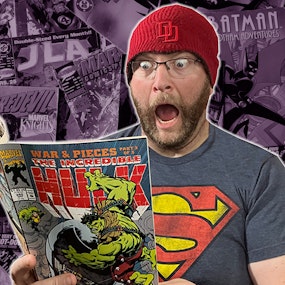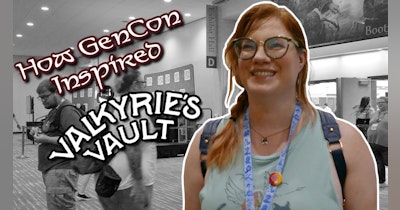RECAP
Joe Quesada revisits Marvel's Man Without Fear! Marvel Editor-in-Chief Joe Quesada makes his long-awaited return to the drawing board for a very special and very personal DD tale. For the first time writing and illustrating, DD legend Quesada crafts a mystery set during the deadliest heat wave in NYC history. A serial killer is on the loose, pushing a city already past its breaking point over the edge, and Daredevil must battle the heat and fear to keep a crumbling Hell's Kitchen together...by any means necessary! Collecting DAREDEVIL: FATHER #1-6
CREATIVE TEAM & COMIC SERIES INFO
- Author: Joe Quesada
- Penciler: Joe Quesada
- Inker: Danny Miki
- Colorist: Richard Isanove
- Letterer: Chris Eliopoulos
- Publisher: Marvel Comics
- Genre: Action, Drama, Mystery, Psychological, Superhero
- Published Dates: 04/08/2004 - 11/15/2006 (six issues)
REVIEW
As a huge fan of Daredevil, I'm always on the lookout for collected editions and runs of the "Devil of Hell's Kitchen." A couple of years ago, I was perusing through some trade paperbacks that a vendor at a local comic convention was selling, and one of those trade paperbacks stood out to me; a copy of Daredevil: Father written and drawn by Joe Quesada with the artistic team of Danny Miki, Richard Isanove, and Chris Eliopoulos. It was the title and artwork that captured my attention as the art was vastly different than any other cover art of Daredevil that I've seen before. So I bought it, took it home with me, and placed it with my other Daredevil trades.
When I finally read this series somewhere in between the Mark Waid and Brian Michael Bendis run, it became an instant favorite for me. This story evoked emotional responses in me, and after reaching the end of the story, I went back to confirm if the details revealed at the end were there in the story all along (yes, they were). It is truly unlike any other Daredevil story you've read before for so many reasons.
Writing
Quesada (The Amazing Spider-Man, Uncanny X-Men, Superman) writes a phenomenal story in his take on Matt Murdock / Daredevil. This reads as a superhero murder mystery, where a serial killer is on the loose in New York City, but Daredevil has no worries since the murders aren't in Hell's Kitchen. In the meantime, he's trying to resolve his issues with the newest superhero team, the Sanetarians, who keeps pushing him around in the hopes that they'll work with him (an odd way to express that). In the professional life of Matt Murdock, he's taken a legal case for Maggie Farrell, a woman who is diagnosed with cancer thanks to New Jersey Power and Light, but her husband seems to hold animosity towards Matt and is a bit hostile towards her.
One of the strengths of the writing here is how Quesada sets up the long game from issue 1. By the time the reader gets to issue 5, we start to see that there are not only one but multiple twists to the story, revealing a shocking revelation of who the serial killer is (nicknamed "Johnny Sockets" by the media because the killer would remove the victims' eyes from their skull), as well as how the killer is tied to Matt Murdock's past. By the time you read the end of issue six, you're truly shocked as you're not expecting the story you just read (which ends up being captivating and makes you question what you thought you knew about the story of Matt Murdock as Daredevil).
Quesada was able to Daredevil's origins as a central part of his story, framing the conversation around Matt's complicated relationship with his father, while also being able to add additional information and layer to it without changing canon. Being able to accomplish that feat is very impressive given that he created a new story in Daredevil without changing anything of substance with the character or his origin story. The story begins and ends with Matt narrating about the person that his father was. The beginning issue had a somewhat complicated outlook of "Battlin' Jack" Murdock, but by the end of the series, Matt has made peace with the man that his father eventually became, even in the midst of all of his mistakes. Quesada dedicated the book to his father who had passed away at the time, so having the story framed around the relationship between Matt and Jack Murdock was truly inspiring and emotional.
Quesada did take a crack at social commentary towards the sensationalism of news and journalism during the time, giving the news reporters ridiculous names such as "Kand Cotten" (as in cotton candy), and their insensitivity towards delicate topics such as murder (the news anchors discussed who should play the role of the killer when the movie inevitably releases, even though the serial killer was yet to be caught). It was also unclear why New York City's heat wave was necessary as part of the story, but these were minute details that didn't detract from enjoying it overall.
Artwork
The artwork here is probably the strongest and weakest element of the story at the same time. The inks by Miki (Spawn, Batman, Ultimate X-Men) were fantastically wonderful. The colors by Isanove (Ultimate X-Men, Guardians Of The Galaxy, Supreme Power) were brilliant to say the least, especially in flashback scenes where the colors were brightly monochromatic, which allowed differing colors (mostly red) to pop out in that scene to show its importance: the redness of a gun during a flashback in shades of blue shows how that items will change lives and holds consequences, and the red irises in Jack's eyes demonstrate how he had the devil in him when he was committing personal acts of violence as a goon in order to make ends meet. The letters by Eliopoulous (Savage Dragon, Ultimate Spider-Man, X-Force) were done well. The artwork by Quesada is not exactly my style but I appreciated it for what it was worth. At first, there were many moments where Daredevil's body was at disproportions or contorted. He would have an extremely large upper body but almost skinny legs, which didn't match inside the panel or with other depictions of Daredevil's physique either. This was distracting until I thought how Quesada may have not been drawing for the entire story, but capturing the emotion and scene being expressed in that particular panel, regardless of what came next. So when one thinks about how each panel in the story was like its own canvas, the art actually made sense and worked well in that regard.
Cover Art
As I mentioned before, the covert art for the trade paperback is what captured my attention. All of the cover art for each issue is credited to Joe Quesada. Each cover of the series was heavily colored in red and black, with small/little shades of white. What I personally loved about the cover art in issue 5 is how it almost looks like John Wesley Shipp from the 90s The Flash but in a Daredevil costume, and issue 6 has the word "Father" drawn and boxed in a way that makes Daredevil appear to be stuck. Using black, white, and red heavily with no other colors and the use of black for creating a kind of white space, these covers will always be memorable.
FINAL THOUGHTS
If someone were to ask me what would be a good introduction to Daredevil, this series would be on the top of my list. Sure, it wouldn't have all of the major components of the character of Daredevil, but it would give the reader enough to know his origin story and get a sense of who the character is. The writing is phenomenal as anyone who reads it will love the thrill they get by the time they get to the end of the story, and its heartfelt focus on the relationships between father and their children is an emotional roller coaster ride you won't forget!
REVIEW SCORE
- Writing - 9.5/10
- Storyline - 9.5/10
- Art - 8.5/10
- Color - 9.5/10
- Cover Art - 9/10
- Overall - 9.2/10
This review was originally written and published for Comic Watch on June 23rd, 2023.






















